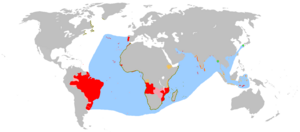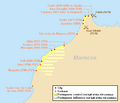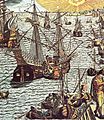Portuguese Empire facts for kids
The Portuguese Empire (in Portuguese: Império Português) was the first global empire in history. It was a huge network of lands and trade routes controlled by Portugal. This empire spread across many continents, from South America to Africa, India, and Southeast Asia.
It all started with the Portuguese exploration of the world in the 15th century. This empire lasted for almost five centuries, which is longer than the Spanish, British, and French Empires.
The Portuguese Empire was very active in trade. It traded with many different parts of the world, including:
- Goa, Malacca, and Southeast Asia
- China and Japan
- The Spice Islands (also called the Moluccas)
- South Asia, the Persian Gulf, and the Red Sea
- Sub-Saharan Africa
In 1890, the British government sent a strong message to Portugal. This message, called the "1890 British Ultimatum," told Portugal to remove its soldiers from parts of Africa that both countries claimed. The United Kingdom had already taken control of these areas.
Why the Empire Ended
Like other big empires such as the British, French, and German empires, the Portuguese Empire was greatly weakened by the two World Wars in the 20th century. After these wars, powerful countries like the Soviet Union and the United States put pressure on European nations to give up their colonies. Also, people in the colonies started strong movements to gain their independence. By the end of the 20th century, these colonial empires were a thing of the past.
The cost of the Portuguese Colonial War (which lasted from 1961 to 1974) also played a big part in the empire's end. This war, along with growing influence from the Soviet Union among workers, led to the fall of Portugal's government in 1974. A new group, the National Salvation Junta, took over. Their main goals were to stop the wars and let Portugal's African colonies become independent. These changes caused thousands of Portuguese people to leave their homes in Africa and return to Portugal.
After this, civil wars broke out in some of the newly independent countries. Many years later, in 1999, Portugal officially gave Macau back to China.
The Empire's Lasting Impact
Today, seven countries that were once Portuguese colonies still have Portuguese as their official language. These countries, along with Portugal, are part of a group called the Community of Portuguese Language Countries.
Portuguese is now one of the world's most important languages. It is the main language of Brazil, which is the largest country in South America.
Images for kids
-
The Conquest of Ceuta, in 1415, was led by Henry the Navigator and started the Portuguese Empire.
-
The 1494 Treaty of Tordesillas line divided the world between the crowns of Portugal and of Castile.
-
The Portuguese visited the city of Nagasaki, Japan.
-
Portugal was the first European nation to trade with Japan and China. Many sailors on Portuguese ships going to Japan were Indian Christians.
-
Portuguese Fort, one of the best-preserved forts in Bahrain.
-
Portuguese carracks unload cargo in Lisbon. Original drawing by Theodor de Bry, 1593, colored later.
-
St. Francis Xavier asking John III of Portugal for a missionary trip to Asia.
-
A map from 1574 showing the 15 hereditary captaincy colonies of Brazil.
-
The Luso-Hispanic (or Iberian) Empire in 1598, during the rule of Philip I and II, King of Portugal and Spain.
-
The Portuguese victory at the Second Battle of Guararapes ended Dutch presence in Pernambuco.
-
Portuguese India (1502–1961).
-
The Portuguese Cortes wanted the United Kingdom to break up.
-
Brazilian independence greatly hurt the Portuguese Empire, both economically and politically, for a long time.
-
The front of St. Paul's College in Macau, 1854.
-
António de Oliveira Salazar wanted to keep Portugal as a nation with lands on many continents.
-
Vasco da Gama's departure to India in 1497.
-
Portuguese discoveries and explorations: first arrival places and dates; main Portuguese spice trade routes (blue).
-
The carrack Santa Catarina do Monte Sinai showed the power of the Portuguese Armada.
-
The Se Cathedral in Goa, India, is an example of Portuguese architecture and one of Asia's largest churches.
-
Portuguese is still an official language in Macau, along with Chinese.
See also
 In Spanish: Imperio portugués para niños
In Spanish: Imperio portugués para niños
































